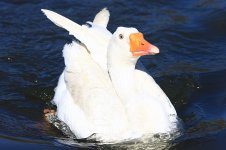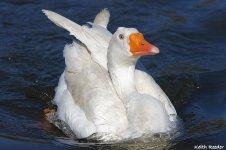-
Welcome to BirdForum, the internet's largest birding community with thousands of members from all over the world. The forums are dedicated to wild birds, birding, binoculars and equipment and all that goes with it.
Please register for an account to take part in the discussions in the forum, post your pictures in the gallery and more.
You are using an out of date browser. It may not display this or other websites correctly.
You should upgrade or use an alternative browser.
You should upgrade or use an alternative browser.
Photographing Black and White Birds... (1 Viewer)
- Thread starter Dimitris
- Start date
More options
Who Replied?Dimitris
Birdwatcher in Oz
Photograph brown birds!!
On a serious note ensure good eye-detail and highlight and avoid direct/bright sunlight.
Good editing skills will enable you to recover some lost detail through under or over exposure. Try to keep neutral-toned backgrounds.
Good luck
Russ
Sorry we don't have that many brown birds in Australia
Thanks for the tips. It was also suggested that increase the aperture to reduce the light entering the lens when photographing white subjects under bright conditions. Is this also worth it?
Keebs
If I fire off enough shots, maybe just one of 'em
I had similar problems trying to snap Ibis and Cockies in Centennial park recently.
Even in the shade I was using -ve EC of up to 1
In sunlight, -2 (My camera's limit) and I still needed to recover in RAW conversion.
Being from England I never thought I'd get to complain about too much light :-O
Even in the shade I was using -ve EC of up to 1
In sunlight, -2 (My camera's limit) and I still needed to recover in RAW conversion.
Being from England I never thought I'd get to complain about too much light :-O
AndyMc
Well-known member
Thanks for the tips. It was also suggested that increase the aperture to reduce the light entering the lens when photographing white subjects under bright conditions. Is this also worth it?
If you are using one of the 'auto' exposure modes, then your camera will compensate for the aperture reduction by decreasing the shutter speed to gain the same amount of light.
I'd suggest using aperture priority for starters & adjust with exposure compensation. Turn on the 'blinkies' (highlight alerts) when you review on the screen, & that will help with avoiding too much blow out with white birds. Simply adjust the compensation you dial in for your next shot until you are happy.
Have a google on 'exposure compensation (EV)' & 'exposing to the right (ETTR)'. You'll find loads of info from folk who can explain a lot better than I can.
Keith Reeder
Watch the birdie...
Actually, depending on the overall scene and the metering mode in use, underexposing can be the worst thing to do to protect highlights (which I presume is Dimitris' problem) - Google "add light to white".
It's also worth being selective about choice of converter - some are much, much better than others at dealing with and recovering highlights.
I never underexpose to deal with highlights and do pretty well - the original below is deliberately "over" exposed by 1/3 of a stop, and still recovers well.
It's also worth being selective about choice of converter - some are much, much better than others at dealing with and recovering highlights.
I never underexpose to deal with highlights and do pretty well - the original below is deliberately "over" exposed by 1/3 of a stop, and still recovers well.
Attachments
AndyMc
Well-known member
There are a few benefits of ETTR, which is why I suggested the google option, there's also numerous threads on here.
In addition to being able to recover highlights efficiently, evident 7D noise at higher ISO's (the old chestnut for pixel peepers) can also be reduced during processing by turning down the exposure level. Therefore ETTR is not a problem unlike ETTL.
In addition to being able to recover highlights efficiently, evident 7D noise at higher ISO's (the old chestnut for pixel peepers) can also be reduced during processing by turning down the exposure level. Therefore ETTR is not a problem unlike ETTL.
Last edited:
Keith Reeder
Watch the birdie...
Actually, "evident" 7D noise can be reduced simply by not pixel peeping in the first place.evident 7D noise at higher ISOs (the old chestnut for pixel peepers)
Keith Reeder
Watch the birdie...
Cheers folks,
Don't have much time atm, but I did google 'add light to white' and all I got on page one was songs...
Strange - I get this.

If you are logged in to google (e.g., because you are also using Gmail) there will be a filtering of your results depending on which kind of links you have clicked in the past.
One example I read were two people googling BP and Gulf of Mexico right after the start of the oil spill, one got responses for stock quotes and the other environmental news.
Niels
One example I read were two people googling BP and Gulf of Mexico right after the start of the oil spill, one got responses for stock quotes and the other environmental news.
Niels
Basically exposure metering only works 'properly' if you meter from a reasonably average shade. You might get away with a black and white bird as the colours will average out to grey but if the bird is completely black, or completely white, and you crop nice and tightly so the meter only sees the bird not the background it is never going to give good results.
I find the simplest solution is, when in any sort of doubt, just point the camera at any sort of mid tone grey/brown/green background in the same light (sun/shade) as the subject, meter and lock in the exposure. Then point the camera at your subject and take the photo. It is also a good idea to do this if you are tracking a moving bird and the bird is crossing varied dark/light backgrounds.
I find the simplest solution is, when in any sort of doubt, just point the camera at any sort of mid tone grey/brown/green background in the same light (sun/shade) as the subject, meter and lock in the exposure. Then point the camera at your subject and take the photo. It is also a good idea to do this if you are tracking a moving bird and the bird is crossing varied dark/light backgrounds.
I find the simplest solution is, when in any sort of doubt, just point the camera at any sort of mid tone grey/brown/green background in the same light (sun/shade) as the subject, meter and lock in the exposure. Then point the camera at your subject and take the photo. It is also a good idea to do this if you are tracking a moving bird and the bird is crossing varied dark/light backgrounds.
That's my practice also; meter some intermediate object, lock-in the exposure, recompose & shoot. It's rough & ready, but works most of the time. I'm generally in spot mode for bird photography, making it particularly easy to get accurate readings on small substitute targets.
Users who are viewing this thread
Total: 2 (members: 0, guests: 2)





